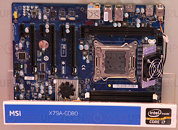- Joined
- Oct 9, 2007
- Messages
- 47,402 (7.52/day)
- Location
- Hyderabad, India
| System Name | RBMK-1000 |
|---|---|
| Processor | AMD Ryzen 7 5700G |
| Motherboard | ASUS ROG Strix B450-E Gaming |
| Cooling | DeepCool Gammax L240 V2 |
| Memory | 2x 8GB G.Skill Sniper X |
| Video Card(s) | Palit GeForce RTX 2080 SUPER GameRock |
| Storage | Western Digital Black NVMe 512GB |
| Display(s) | BenQ 1440p 60 Hz 27-inch |
| Case | Corsair Carbide 100R |
| Audio Device(s) | ASUS SupremeFX S1220A |
| Power Supply | Cooler Master MWE Gold 650W |
| Mouse | ASUS ROG Strix Impact |
| Keyboard | Gamdias Hermes E2 |
| Software | Windows 11 Pro |
Meet the X79A-GD80 from MSI, where active component cooling is making a comeback to motherboards. The Sandy Bridge-E LGA2011 socket dwarfs everything around it, in the upper-half of the board. Typical of LGA2011 motherboards,the X79A-GD80 has two DDR3 DIMM slots on either sides of the CPU socket, supporting quad-channel DDR3 memory. The VRM area is above the socket, MSI used a 40 mm fan-heatsink to cool the VRM. Further, a fan-heatsink is used to cool the X79 PCH. With the PCH heatsink the use of fan is more of an effort to keep the heatsink small in size, so active air-flow can compensate for its size. That aside, expansion slots are all-PCIe, including three PCI-Express 3.0 x16 (x16/x8/x16), and four PCI-E x1 in middle. All 10 of the SATA 6 Gb/s ports from the PCH are internal ports, with just the one eSATA. Other connectivity includes 8+2 channel HD audio, dual gigabit Ethernet, and USB 3.0.

View at TechPowerUp Main Site

View at TechPowerUp Main Site
Last edited:






